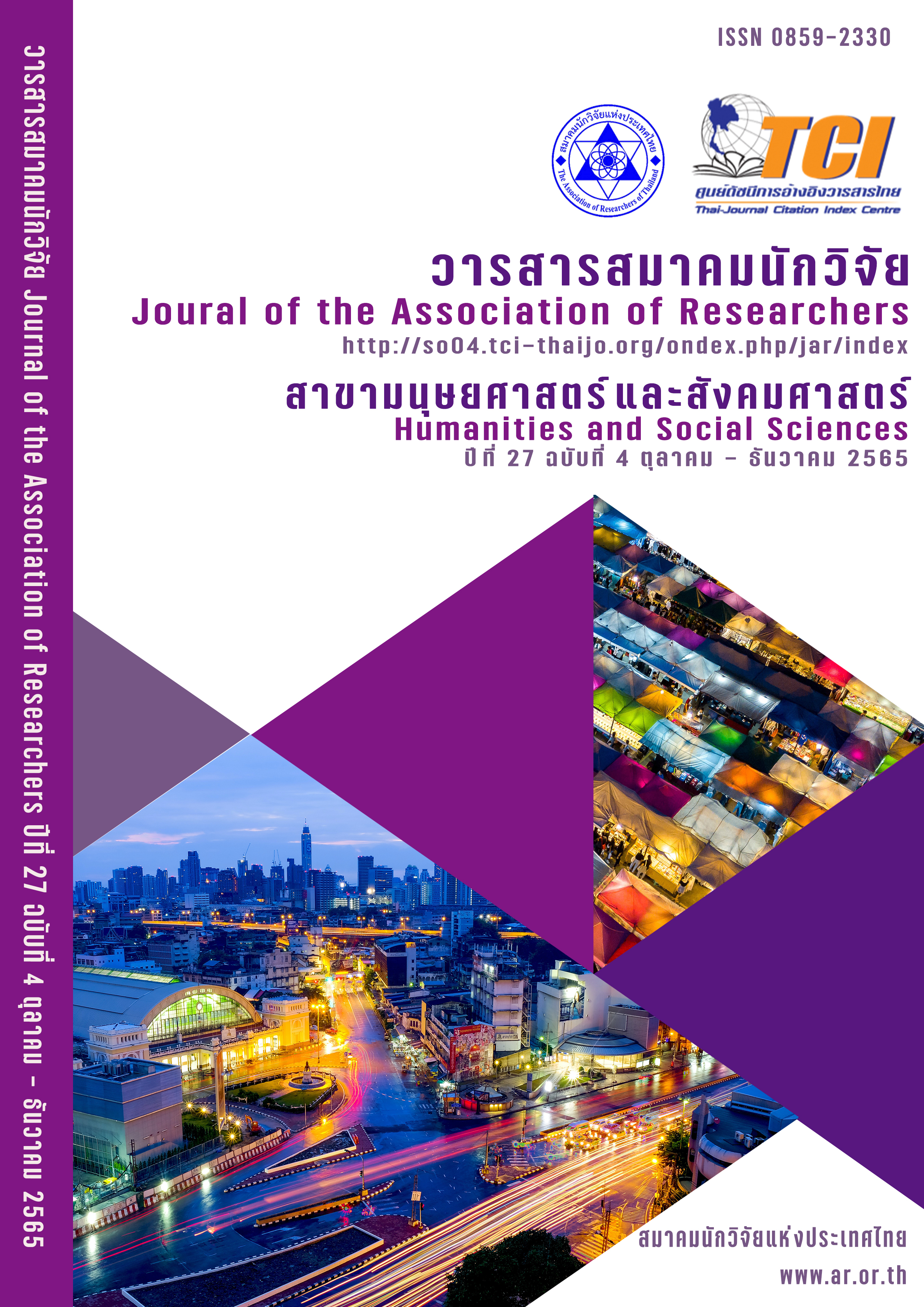The Model of Ability Enhancement for the Elderly Using Communication Technology in New Normal Era.
Main Article Content
Abstract
The purposes of this research were to study 1) the level of the elderly’s ability to use communication technology, 2) the factors affecting the ability of the elderly to use communication technology, and 3) develop a model to increase the ability of the elderly to use communication technology in the new normal era. The sample of quantitative research was 410 elderly people aged 60 years and over in 10 districts with a large number of elderly people such as Samphanthawong, Pom Prap Sattru Phai, Bang Rak, Phra Nakhon, Bangkok Noi, Klong Sam Wa, Nong Chok, Lat Krabang, Min Buri, and Bang Khun Thian. Collecting data with questionnaires, and analyzing the statistical data using the structural equation modeling techniques. In the qualitative research, 15 key informants were executives involved in elderly care in 10 districts of Bangkok. The data was collected through in-depth interviews and content analysis. The results of this research found; 1) the ability to use communication technology, social network, and financial management was moderate, and the attitudes and perceptions were at a high level. 2) social networks, attitudes, perceptions, and financial management positively influence the ability to use communication technology statistically significant at the .01 level. 3) Develop a model to increase the ability of the elderly to use communication technology in the new normal era as the government should promote learning to use simple technology, install a high-performance internet signal to cover all areas, the authorities training should be provided to educate the elderly to be able to use communication technology, encouraging children to educate the elderly on how to use communication technology.
Article Details

This work is licensed under a Creative Commons Attribution-NonCommercial-NoDerivatives 4.0 International License.
บทความที่ปรากฏในวารสารนี้ เป็นความรับผิดชอบของผู้เขียน ซึ่งสมาคมนักวิจัยไม่จำเป็นต้องเห็นด้วยเสมอไป การนำเสนอผลงานวิจัยและบทความในวารสารนี้ไปเผยแพร่สามารถกระทำได้ โดยระบุแหล่งอ้างอิงจาก "วารสารสมาคมนักวิจัย"
References
กรมสุขภาพจิต. (2563). ก้าวย่างของไทย สู่ ‘สังคมผู้สูงอายุ’ อย่างสมบูรณ์แบบ. สืบค้นเมื่อ กุมภาพันธ์ 2, 2565. จาก https://www.dmh.go.th/news-dmh/view.asp?id=30476.
กระทรวงการอุดมศึกษา วิทยาศาสตร์ วิจัย และนวัตกรรม. (2564). ชีวิตวิถีใหม่และการปรับตัวในภาวะ COVID-19. สืบค้นเมื่อ กุมภาพันธ์ 20, 2565. จาก http://www.tosh.or.th>covid-19>index.php>new-normal.
กัญญรัตน์ หงส์วรนันท์. (2563). กลยุทธ์การสื่อสารผ่านเครือข่ายทางสังคมในการเตรียมความพร้อมสู่สังคมผู้สูงอายุ. วารสารการสื่อสาร มหาวิทยาลัยราชภัฎเชียงราย, 3(3), 124-139.
กวีพงษ์ เลิศวัชรา. (2555). การศึกษาปัญหาการเรียนรู้เทคโนโลยีของผู้สูงอายุ. กรุงเทพฯ: วิทยาลัยนวัตกรรม มหาวิทยาลัยธรรมศาสตร์.
เกศกนก ยิ้มแย้ม. (2562). การเลือกใช้แอปพลิเคชันไลน์ของกลุ่มผู้สูงอายุ. วารสารระบบสารสนเทศด้านธุรกิจ (JISB), 6(1), 21-39.
ธิดารัตน์ สาระพล. (2561). ความต้องการสารสนเทศของผู้สูงอายุเพื่อพัฒนาคุณภาพชีวิตของผู้สูงอายุโรงเรียนผู้สูงอายุตำบลมะอึ อำเภอธวัชบุรี จังหวัดร้อยเอ็ด. วารสารวิจัยชุมชน NRRU, 12(3), 32-46.
พิมพ์ใจ ทายะติ. (2560). รูปแบบการจัดการเรียนรู้สาหรับผู้สูงอายุประเทศไทยเพื่อการรู้เท่าทันเทคโนโลยีสารสนเทศ และการสื่อสาร. วารสารวิชาการ Veridian E - Journal, Silpakorn University, 10(3), 1613-1629.
ภัทริกา วงศ์อนันต์นนท์. (2561). เทคโนโลยีสารสนเทศต่อสังคมผู้สูงอายุ. วารสารทหารบก, 19(4), 27-32.
มนัสสินี บุญมีศรีสง่า. (2561). รูปแบบการใช้สื่อโซเชียลมีเดียของผู้สูงอายุในสังคมไทย กรณีศึกษาเขตกรุงเทพมหานคร. กรุงเทพฯ: คณะวิทยาการจัดการ มหาวิทยาลัยศิลปากร.
มูลนิธิสถาบันวิจัยและพัฒนาผู้สูงอายุไทย. (2564). เผยสถิติผู้สูงอายุที่มีรายได้น้อยเข้าถึงเทคโนโลยีดิจิทัลเพื่อติดตามข่าวสารได้เพียงร้อยละ 12.9. สืบค้นเมื่อ กันยายน 3, 2565, จาก https://thaitgri.org/?p=39879.
วรรณพงษ์ ดุรงคเวโรจน์. (2560). เครื่องมือใหม่ในการวิเคราะห์ความเหลื่อมล้ำของรายได้: กรณีศึกษาประเทศไทย. วารสารเศรษฐศาสตร์ธรรมศาสตร์, 35(2), 29-48.
วีรณัฐ โรจนประภา. (2560). พฤติกรรมการใช้เทคโนโลยีที่มีผลต่อระดับความสุขของผู้สูงอายุในเขตกรุงเทพมหานคร. วารสารวิชาการบัณฑิตวิทยาลัยสวนดุสิต, 13(1), 89-104.
สารัช สุธาทิพย์กุล. (2561). สภาพปัญหาและการเรียนรู้การใช้เทคโนโลยีของผู้สูงอายุ กรณีศึกษา ผู้สูงอายุที่ใช้สมาร์ทโฟน. กรุงเทพฯ: มหาวิทยาลัยศิลปากร.
สุดารัตน์ พิมลรัตนกานต์. (2555). การเงินส่วนบุคคล. กรุงเทพฯ: ซีเอ็ดดูเคชั่น.
สำนักงานพัฒนาธุรกรรมทางอิเล็กทรอนิกส์ (องค์การมหาชน). (2563). รายงานผลการสำรวจพฤติกรรมผู้ใช้อินเทอร์เน็ตประจำปี 2562. กรุงเทพฯ: สำนักยุทธศาสตร์ สำนักงานพัฒนาธุรกรรมทางอิเล็กทรอนิกส์ (องค์การมหาชน).
Bakar, H. A., & Mustaffa, C. S. (2013). Organizational communication in Malaysia organizations: Incorporating cultural values in communication scale. Corporate Communications: An International Journal, 18(1), 87-109.
Gibson, J. L. (2000). Organizations Behavior (7th ed.). Boston: Irwin.
Haythornthwaite, C. (2006). Facilitating collaboration in online learning. Journal of Asynchronous Learning Networks, 10(1), 7-24.
Hofstede, G., Hofstede, G. J., & Minkov, M. (2005). Cultures and organizations: Software of the mind (Vol. 2). New York: McGraw-hill.
Joreskog, K., & Sorbom, D. (1993). LISREL 8: Structural Equation Modelling with the SIMPLIS Command Language. Chicago: Scientific Software International Inc.
Kelloway, E. K. (2007). Using LISREL for Structural Equation Modeling. A Researcher’s Guide. Canada: Sage Publications.
Marin, A. & Wellman, B. (2011). Social Network Analysis: An Introduction. London: SAGE.
Meshi, D., Cotten, S. R., & Bender, A. R. (2020). Problematic social media use and perceived social isolation in older adults: a cross-sectional study. Gerontology, 66(2), 160-168.
Newstrom, J. W., & Davis, K. (2002). Human Behavior at Work: Organizational Behavior (8th ed). New York: McGraw-Hill.
Schiffman, L. G., & Kanuk, L. L. (2001). Consumer behavior (5th ed.). Englewood Cliffs. N. J.: Prentice-Hall.
Translated Thai References
Boonmeesrisanga, M. (2018). Social Media Usage Patterns Among the Elderly in Thai Society Case Study in Bangkok. Bangkok: Faculty of Management Science Silpakorn University. (In Thai).
Department of Mental Health. (2020). Thailand’s step towards becoming an ‘elderly society’ perfectly. Retrieved on February 2, 2022, from https://www.dmh.go.th/news-dmh/view.asp?id=30476. (In Thai).
Durongkaveroj, W. (2019). New Methodology in the Analysis of Income Inequality: A Thai Case Study. Thammasat Economic Journal, 35(2), 29-48. (In Thai).
Electronic Transactions Development Agency (Public Organization). (2020). Internet User Behavior Survey Report 2020. Bangkok: Strategy Bureau, Electronic Transactions Development Agency (Public Organization). (In Thai).
Foundation of Thai Gerontology Research and Development Institute. (2021). Statistics revealed that only 12.9 percent of low-income seniors had access to digital technology to keep up with the news. Retrieved on September 3, 2022, from https://thaitgri.org/?p=39879. (In Thai).
Hongworranun, K. (2020). Strategies for Communicating through Social Networks in Preparing for an Aging Society. CRRU Journal of Communication, 3(3), 124-139. (In Thai).
Lertwachara, K. (2012). The study of technology learning problems of the elderly. Bangkok: College of Innovation, Thammasat University. (In Thai).
Ministry of Higher Education, Science, Research and Innovation. (2021). New Normal, new lifestyle and adaptation in the time of COVID-19. Retrieved on February 20, 2022, from http://www.tosh.or.th>covid-19>index.php>new-normal. (In Thai).
Pimolratanakan, S. (2012). Personal Finance. Bangkok: SE-Education.
Rodjanaprapha, W. (2017). Behavioral of Using Technology Affecting the Happiness Levels of the Elderly in Bangkok Metropolitan. Suan Dusit Graduate School Academic Journal, 13(1), 89-104. (In Thai).
Saraphon, T. (2018). Information Needs to Improve Quality of Life for the Elderly of Elderly School in Ma-Aue Sub-District Thawatburi District, Roi-Et Province. Community Research Journal NNRU, 12(3), 32-46. (In Thai).
Suthatipkul, S. (2018). The Problem and Process of Learning to use the Smartphone Technology of the Elderly People in Surrounding Area Phra Pinklao, Bangkok Noi District in Bangkok. Bangkok: Silpakprn University. (In Thai).
Tayati, P. (2017). The Model of Thai Elderly Learning Management for Information and Communication Technology Literacy. Veridian E-Journal, Silpakorn University, 10(3), 1613-1629. (In Thai).
Wonganatnont, P. (2018). Information Technology for Aging Society. Journal of The Royal Thai Army Nurses, 19(4), 27-32. (In Thai).
Yimyam, K. (2019). Usage of Line Application in Elderly. Journal of Information Systems in Business (JISB), 6(1), 21-39. (In Thai).


